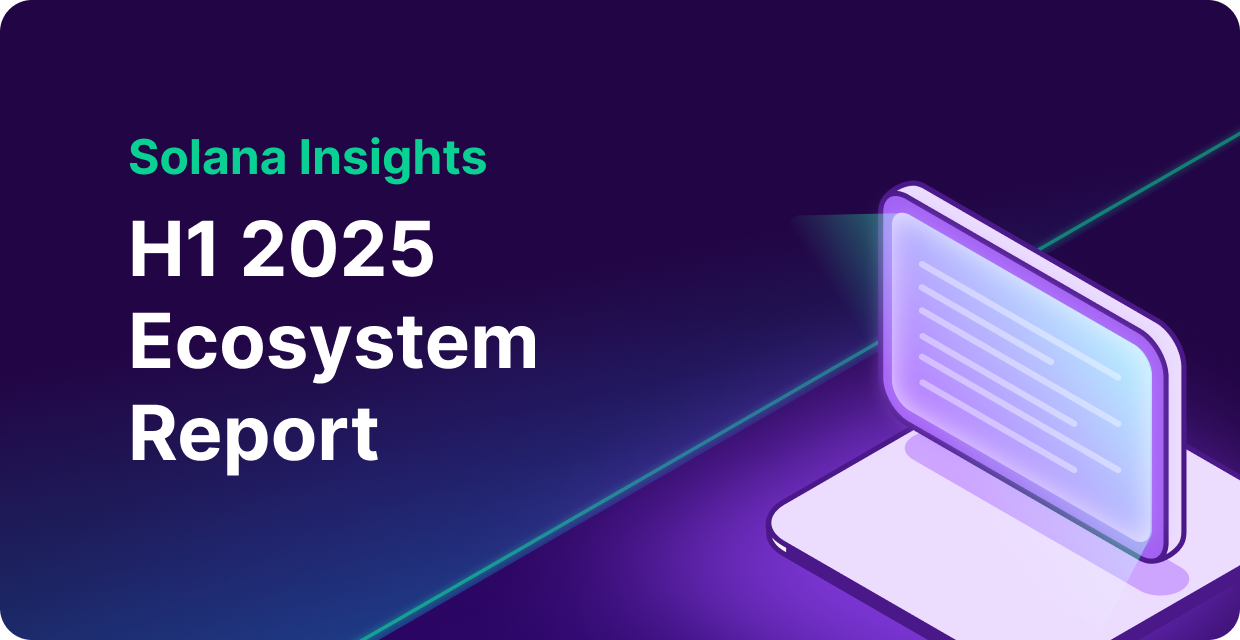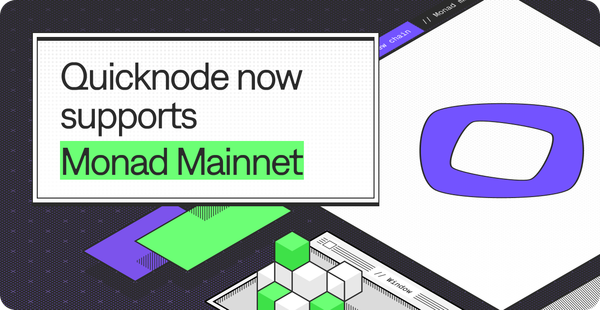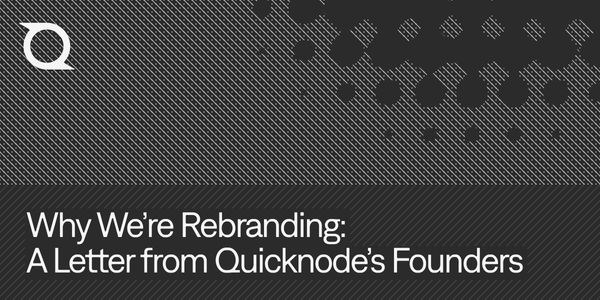Solana H1 2025 Ecosystem Report: DeFi, RWA, and Institutional Growth
Learn more about Solana as we breakdown the network’s performance, DeFi growth, stablecoins, RWAs, dev activity, and what's next.

Report highlights:
- Solana achieved 18+ months perfect uptime processing 162M daily transactions
- DeFi thrived with $8.9B TVL, $1.05T DEX volume, and 80M active wallets.
- Stablecoin supply doubled to hit $11.2B with 4.4M daily users
- The RWA sector surged 150% to ~$418M attracting BlackRock, Apollo, Franklin Templeton
- Upgrades like Alpenglow and Firedancer promise sub-400ms finality by 2026.
The first half of 2025 was a defining stretch for Solana.
What began as a network known for speed is now evolving into an enterprise-grade platform powering DeFi, RWAs, stablecoins, and consumer apps at scale.
Let’s dive right into a few highlights of the Solana network:
- 18 months with no network outage and 100% uptime
- Processing more daily transactions than Ethereum, Base, Sui, Hyperliquid, and other major chains combined
- $985.8M in fees generated throughout the network
- Total active stake securing the network stands at 384.4M SOL or $70.3B
- $11.07B in total market cap of stablecoins
- 1052 validators currently live on Solana mainnet
- Partnerships with major traditional giants like PayPal, Shopify, Stripe, Visa
Onchain activity, developer interest, retail user engagement, institutional partnerships — Solana is unlocking growth in all 360 degrees possible.
This report breaks down Solana’s performance in H1 2025 across key metrics, sectors, and upgrades, and offers a clear look at where it’s headed next.
A Quick Primer on Solana’s Network Performance
Solana, in H1 2025, has proved by speed, throughput, and reliability that the network can handle billions of dollars, users, and transactions — all at the same time.
Key highlights from H1 2025 include:
- 100% uptime for 18+ months — no outages since February 2023
- Averaging 162 million transactions/day
- Sustained 1,000+ TPS, with block times at ~400ms
- Median transaction fee under $0.01, even during peak demand
- Transaction success rate rose to 62%, up from 42% in early 2024
- Skip rates fell below 0.3%, showing near-flawless block production
- Solana processes more daily transactions than all major L1s combined
Sources: Solana - DefiLlama; Artemis Terminal, Token Terminal, Solana Key Metrics, Solana: Onchain Activity - Blockworks, Solana Network Health Report: June 2025, Insights: Layer 1 & 2 Chains - June 2025
These metrics collectively paint a picture of a network that can not only scale well, but also has matured infrastructure in terms of stability and efficiency.
With this foundation in place, let’s explore how it powers one of Solana’s strongest verticals: decentralized finance.
State of Decentralized Finance (DeFi) on Solana H1 2025
Solana's DeFi ecosystem scaled higher highs in H1 2025 with the network now capturing 43% of all global DEX volume and processes 81% of all blockchain DEX transactions which is more than double its nearest competitor.
Here are a few metrics that stood out to us:
- $1.05 trillion in cumulative DEX trading volume across H1
- ~$8.9 billion in TVL, with 18% growth QoQ
- $1.6 billion in DApp revenue generated — 4× growth over H1 2024
- 51.7M SOL (~13% of staked SOL) locked in liquid staking protocols
- 80M active wallets used Solana on average throughout 2025 H1
Drivers of DeFi growth on Solana
- High-performance infrastructure
Solana’s low fees, fast finality (~400ms blocks), and high throughput (1,000+ TPS) make it ideal for DEXs, perps, and automated market makers.
- Memecoins and token launchpads
Memecoins exploded in early 2025 with platforms like Pump.fun generating 60%+ of all dApp revenue. Over 80% of all memecoins launched were on Solana.
- Liquid staking
Liquid staking emerged as a major growth driver, capturing 51.7 million SOL (12.8% of all staked tokens) adding liquidity to lending markets and vaults.
- DEX aggregation
Jupiter remains the dominant aggregator (~90% share) on Solana and handles over 50% of all DEX aggregator volume across chains.
DeFi on Solana is setting the pace for all other sectors, protocols, and even blockchains in terms of liquidity and composability.
State of Stablecoins on Solana H1 2025
Stablecoins are the lifeblood of decentralized finance, and in H1 2025, Solana emerged as a premier destination for their issuance and utilization. The network now holds over $11.2 billion in circulating stablecoins, making it the #3 blockchain by stablecoin supply behind only Ethereum and Tron.
Here are a few numbers that stood out:
- $11.2 billion in total stablecoin market cap
- 264+ million stablecoin transfers worth $59.2 billion in January alone
- ~4.4 million daily active stablecoin users in Q1
- $1.75 billion USDC minted by Circle in May 2025 alone
Growth Drivers of Stablecoin Usage on Solana
- Real-world demand meets real-time infrastructure
People use stablecoins when they work. On Solana, they’re fast, final, and cheap — with transfers costing fractions of a cent. The network’s low fees (under $0.01) and 400ms block times make it a natural fit for high-volume, cross-border payments, attracting fintech giants and merchants alike.
- Institutional trust and integration
PayPal, Stripe, Shopify, and Visa integrations, plus innovations like Solflare’s debit card are quietly pushing more fiat-to-stablecoin flows into Solana rails.
- Token extensions unlock compliance and programmability
Solana’s Token-2022 framework gives developers fine-grained control: transfer hooks, confidential transfers, and freeze authorities.
- Rise of alternatives beyond USDC and USDT
Stablecoin diversity improved with yield-bearing stablecoins like USDY and syrupUSDC growing rapidly. The market is now not only bigger but it’s more layered, with products built for payments, yield, and RWAs.
Stablecoins on Solana are stable, liquid, composable, and hence it's no surprise that retail and institutions are actually using stablecoins on the network.
State of Real-World Assets (RWA) on Solana H1 2025
Solana has quietly become the fastest-growing chain for real-world assets.
In H1 2025 alone, Solana’s RWA market grew by over 150%, with total RWA token value reaching ~$418 million — easily outpacing all other chains in growth rate.
Behind these numbers are a bunch of initiatives that reflect Solana’s active role in bridging traditional finance with blockchain:
- Ondo Finance: Tokenizing US Treasuries with USDY at $175.3 million and OUSG at $79.6 million market caps, offering yield-bearing assets.
- BlackRock BUIDL Fund: Tokenized money market fund with $20 million issued on Solana, part of a $2.9 billion AUM fund, targeting accredited investors.
- Franklin Templeton FOBXX: Tokenized U.S. Government Money Fund with $23 million on Solana, managing over $700 million in assets.
- VanEck VBILL: Tokenized treasury-bill fund with $8 million issued, tailored for institutional investors with a 0.20% management fee.
- Apollo ACRED: Tokenized private credit fund offering 9.5% APR yield, integrated with Solana-based DeFi protocols.
Apart from these, xStocks backed by Kraken, Baxus, and more companies are operating in the RWA space on Solana.
Growth Drivers of RWA adoption on Solana
- High-speed infra + Token-2022 = enterprise-ready RWA rails
Institutions want programmability, compliance tools, and guaranteed performance. Solana’s Token Extensions (e.g. transfer restrictions, freeze authority) and sub-second finality give them both.
- Rising demand for yield-bearing stablecoins and credit
Tokens like USDY (backed by Treasuries), OUSG, and ACRED (tokenized private credit) have become on-chain treasury primitives.
DeFi protocols like Kamino and Credix now accept them as collateral or LP assets.
- Growing diversity of asset types and issuers
Beyond funds: Solana now hosts tokenized real estate (Parcl), commodities (Oro’s tokenized gold, Uranium Digital), collectibles (Baxus’ whiskey vaults), and more.
- High signal for institutions
BlackRock's decision to launch BUIDL on Solana, followed by Apollo Global's first-ever DeFi-integrated credit fund, signals that major asset managers view Solana as institutionally ready.
Solana's H1 2025 performance in the RWA sector clearly positions it as a preferred blockchain for the tokenization of real-world assets.
Solana Developer and Ecosystem Growth in H1 2025
H1 2025 marked a significant influx of new talent, continuous improvements in tooling, and expansion of the Solana's developer ecosystem. Throughout the period, Solana averaged 2,500–3,000 monthly active developers, including some of the highest retention and onboarding rates in the industry.
Here are the developer metrics that defined H1 2025:
- The Colosseum Breakout Hackathon saw 1412 submissions
- Community initiatives like Superteam now span 19+ countries
- Over 1,600+ project submissions were made across domain-specific events like Solana AI, ZK compression, and Real-time dApps.
- More than $750,000 USD in prize funding was distributed across these hackathons.
Growth Drivers Of Developer Ecosystem Expansion
- Mature tooling and developer resources
Frameworks like Anchor, SDKs, explorer tools, Token Extensions, and open-source templates now give devs a shorter runway from idea to mainnet.
- Emergence of identity and compliance tools
The Solana Attestation Service (SAS) launched, providing a public good for associating off-chain data (like KYC checks or accreditation) with on-chain accounts in a verifiable and reusable manner.
- Improved testing and simulation
Surfpool emerged as a fast, developer-friendly simulation of Solana Mainnet that runs on local machines.
Solana's commitment to attracting builders and developers through robust tooling and strategic community initiatives is reaping rewards. With the talent flywheel spinning, the next wave of composability and innovation is already in motion on Solana.
Institutional Adoption of Solana in H1 2025
Solana is cementing its reputation as an enterprise-grade blockchain capable of handling the stringent demands of traditional finance. H1 2025 only accelerated it with strategic partnerships, direct capital allocation, and RWA product launches.
Why Institutions Are Turning to Solana
- Solana has real economic gravity now
$1T+ in DEX volume. Billions in stablecoin liquidity. Verified user demand. Institutions don’t want to build in a vacuum — they want to plug into where usage already is.
- The world’s biggest fintechs are already here
PayPal, Stripe, Shopify, Visa — all have stablecoin or payment rails touching Solana. This de-risks the decision for more players to enter the stack.
- TradFi’s trust is showing up in action
From Franklin Templeton calling Solana 'institutionally focused' to BlackRock choosing it for BUIDL issuance shows their trust in the network.
- Regulatory clarity created institutional confidence
With the GENIUS Act passing the Senate as a comprehensive federal stablecoin legislation, institutions are trusting stablecoins more.
The main reason for this to happen is Solana’s pitch to institutions not being ideology or fantasy, it’s the infrastructure that works. Let’s now look at how that infrastructure is being strengthened — through core protocol upgrades like Alpenglow and Firedancer.
Solana Network Upgrades: Alpenglow and Firedancer
Solana’s core engineering focus in H1 2025 was clear: strengthen reliability, increase throughput, and set the stage for global-scale adoption.
Two major network upgrades — Alpenglow and Firedancer — are central to this mission.
Alpenglow: Deterministic Finality is Almost here
Alpenglow is Solana’s most significant consensus upgrade since genesis. It replaces the legacy Tower BFT and Proof of History (PoH) voting system with a new deterministic finality mechanism.
What it will change:
- Finality is now deterministic, not probabilistic, meaning once a block is confirmed, it’s irreversible.
- Average finality time dropped to 100–150 milliseconds, compared to ~12 seconds previously.
- Vote traffic will be drastically reduced, freeing up bandwidth and improving validator efficiency.
- Network latency improved across the board, especially for DeFi, gaming, and CLOB apps.
Why it matters: Alpenglow makes Solana feel like a ‘confirmation = finality’ chain with no waiting or risk of rollback.
Firedancer: Parallel Client, Unmatched Throughput
Firedancer, built by Jump Crypto, is a new independent validator client for Solana written from scratch in C/C++.
H1 2025 progress:
- Firedancer achieved 1.2 million TPS in test environments, proving the system’s scalability ceiling.
- It successfully executed live Solana mainnet blocks during testing, showing compatibility.
- Jump released open benchmarks and timelines — with phased mainnet rollout expected in late 2025.
Why it matters:
- Client diversity: Reduces reliance on Solana Labs’ original validator software. This boosts security and resilience.
- Massive horizontal scaling: Firedancer unlocks orders-of-magnitude performance boosts, enabling everything from high-frequency trading to mass consumer applications.
- Optimized for modern hardware: Firedancer’s architecture makes better use of multicore systems and high-throughput networking.
In simple terms,
- Alpenglow = Instant finality and lower latency
- Firedancer = Next-gen performance and client-level decentralization
These upgrades are foundational. They move Solana from being 'fast enough' and ‘affordable’ to being future-proof.
Understanding What Lies Ahead for Solana in 2025
Solana's trajectory in 2025 is clear: to evolve from a high-performance blockchain into the definitive platform for the internet's capital markets and a broad spectrum of consumer and enterprise applications.
The first half of 2025 proved Solana can support real-world scale — across DeFi, stablecoins, RWAs, and consumer apps — without breaking.
What’s next is about multipliers.
Alpenglow and Firedancer will push performance to new extremes. Token extensions will unlock compliance-ready use cases. And with growing traction from institutions, developers, and global users, Solana’s surface area is only expanding.
Data sources referenced through the report
- Solana – Network Health Report (June 2025)
- Messari – State of Solana Real-World Assets
- Solana DApps Revenue Report
- Solana - DefiLlama
- Artemis Terminal
- Token Terminal
- Solana Key Metrics
- Solana: Onchain Activity - Blockworks
About QuickNode
QuickNode provides the tools and resources builders need to create incredible products. With a globally balanced infrastructure, guaranteed reliability, a user-friendly interface, and end-to-end customer support, QuickNode allows enterprises to realize their ideas on the chain rapidly.





